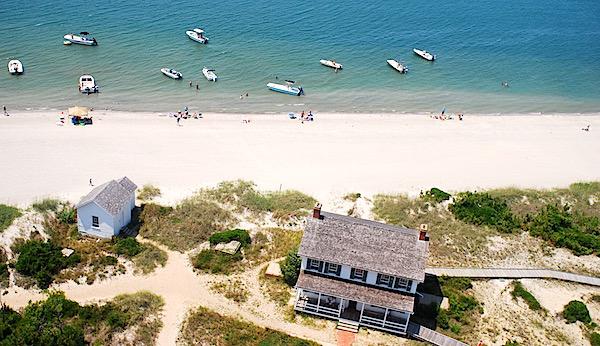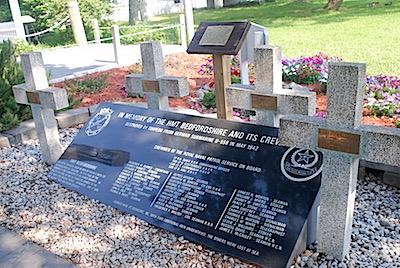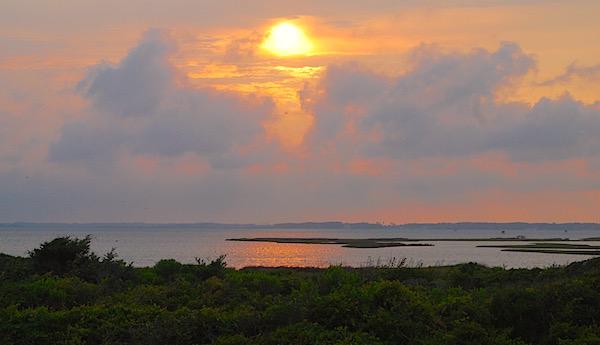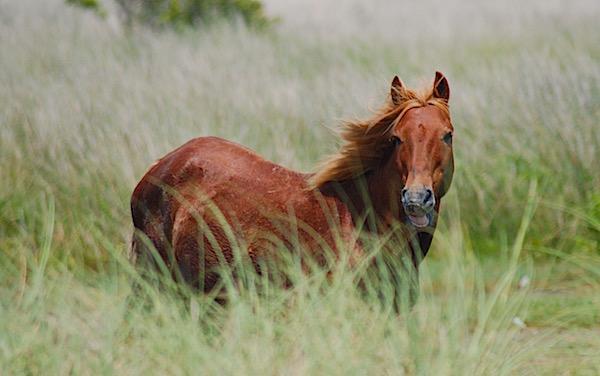Take a quick glance at a map of the Outer Banks and you'll notice how Cape Hatteras National Seashore and Cape Lookout National Seashore are very close neighbors.
If not for Ocracoke Inlet they'd be kissing cousins. Still, they're close enough to make a perfect summer vacation two-step: Cape Lookout and Cape Hatteras.
With visions of warm sea breezes dancing in our minds, four of us set out on such a two-step. It would be a trek that combined vehicles, skiffs, ferries, and some careful timing.
From Cape Lookout's visitor center at Harker's Island, North Carolina, we rode a bucking skiff across Back Sound to Shackleford Banks. These "skiffs" are referred to as ferries, but in reality they're just open-air skiffs you might use on a fishing trip. But they quickly get the job done.
Once we reached Shackleford Banks, we explored this uninhabited barrier island with its beaches and maritime forests. Feral horses, known locally as Banker horses, make their home on the island, and they didn't seem to mind us hiking through the meadows and along the shoreline.
Returning late that afternoon to Harker's Island, we overnighted at a local motel and set out the next morning to catch the automobile ferry to South Core Banks. There we spent a night in one of the seashore's Great Island Cabins, and two days exploring the seashore where sea oats dance in the sea breeze.

The view from atop the Cape Lookout Light makes the climb worth it/Kurt Repanshek
The cabins seem to have been designed with surf casters in mind. They're barebones -- plywood walls, floors and ceilings, with bunkbeds. Outside are fish cleaning stations and barbecue grills -- bring the charcoal. Seagulls quickly notice activity at either location and call their feathered friends. As we grilled steaks, the roof of our cabin became crowded with gulls looking for a tasty morsel. A moment of inattention was rewarded with one gull managing to pull a small filet mignon off the fire. Rather than flying off with it, though, he dropped it and we quickly retrieved it with no harm other than a little sand mixed in with the salt and pepper.
Negotiating South Core Banks is best done with a four-wheel-drive rig. After slightly deflating the tires for better traction we easily moved us up and down the sandy barrier island. At the far south end we climbed to the top of Cape Lookout Light for a panoramic view of the seashore. During the rest of our stay here we roamed dunes and swam in the Atlantic before our schedule forced us north once again.
After a ferry ride back to the mainland, we headed to Cedar Island and on to another, larger, automobile ferry to Ocracoke and Cape Hatteras. The two-and-a-half-hour crossing of Pamlico Sound is perfect for napping, enjoying the views, or catching up on your reading.
At Ocracoke we then caught a skiff to Portsmouth Village (settled in 1753) on the northern tip of Cape Lookout. This historic village gave us some insight into the early settlers, who tended to merchant ships and, in 1894, created the U.S. Life-Saving Service: the precursor to the U.S. Coast Guard. After touring the village we headed out on a trail that led through the maritime forest and out to the beach, which offered some great shelling. After a day of exploration (and feeding its mosquitoes), we headed back to Ocracoke for a night on Cape Hatteras.

A small cemetery at Ocracoke holds the remains of British sailors killed during World War II just off the Outer Banks/Kurt Repanshek
The Ocracoke area offers a lot to see, whether you inspect the historic Ocracoke Light, visit the British cemetery that holds the remains of some sailers killed when their ship was torpedoed off the Outer Banks in 1942, or spend time relaxing at the Ocracoke Campground. A seashore visitor center here is a good place to stock up on reading materials or memorabilia.
While Ocracoke is a great base camp to explore this national seashore, many Cape Hatteras towns offer good lodging and dining options for beach lovers, surf casters, shell hunters, and those in search of rest and relaxation.
You can never adequately design a long-enough vacation, unless you're retired and have no time constraints. During our brief visit we ventured out to Cape Point to see what was biting in the surf, snapped photos of historic Ocracoke Light, scaled Cape Hatteras Light, and even wandered up the coast to visit the Wright Brothers National Memorial.
It wasn't entirely a relaxing trip, but fed our desire to return for another week or two on the Outer Banks.

What better way to end the day than enjoying the sunset over Core Sound?/Kurt Repanshek




Add comment